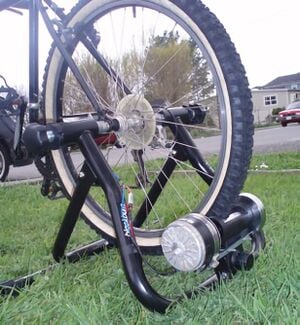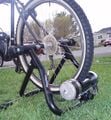
This page is about the "Tour De Volts" project for the Waterpod from the Spring 2009 "Introduction to Design" class at Cal Poly Humboldt. We propose to use a bicycle as a power source to provide a bit of extra energy to the Waterpod. Specifically, we've used a bike trainer to convert a DC motor from a scooter into an electrical generator. This will be on the Waterpod for six months and will serve as an educational tool.
Introduction[edit | edit source]
The Waterpod Project[edit | edit source]
The Waterpod is a self sustaining barge that will float down the East River of New York City, docking at several different Manhattan piers on the Hudson River to teach the public about sustainability. It will be the home to six visual artists and is the client to Cal Poly Humboldt's Engineering 215 class that is designing sustainable projects to be exhibited on board. The aim of the Waterpod Project is to demonstrate the importance of sustainability through art, technology and discussion by giving performances, art installations, lectures, and workshops.
Team Lorax[edit | edit source]
Team Lorax is a team of four students enrolled in Engineering 215 Intro to Design at Cal Poly Humboldt. With the Waterpod Project working as their green client, Team Lorax designed and implemented a sustainable bike generator to be used as an educational and functional tool aboard the barge. The team consists of Emily Bowes (Freshman), Alix George (Freshman), Mike Radenbaugh (Freshman), and Alex Mattson (Sophmore).
-
Fig 1: Bike and Generator
The Challenge and Client Criteria[edit | edit source]
The challenge for Team Lorax was to build an educational and functional bicycle generator that could be used aboard the Waterpod to enhance the learning experience of visitors.
To simplify the design process and meet the standards of the clients, Team Lorax developed a list of criteria based on the wants and needs of the clients. Relative weights were assigned using a scale from 1 to 10 based on the criteria's importance in the final solution:
- Adjustability-(9)-Generator should be adjustable for both children and adult's bikes.
- Durability-(9)-Must withstand daily use for six months.
- Cost-(9)-Less than or equal to $300.00.
- Educational Value-(10)-Must demonstrate human powered energy generation.
- Safety-(8)-Meets New York electrical codes, safe for use.
- Efficiency-(10)-12 V DC, minimal wattage needed.
- Ease of Setup-(8)-Must be easily set up by the client.
- Aesthetics-(7)-Must be presentable and compact.
- Maintainability-(7)-Simple design for easy maintenance by untrained people.
Final Solution[edit | edit source]
The final solution is specifically built to provide human powered electricity for the Waterpod. The bike generator is able to adapt to a wide variety of bicycles so both children and adults can learn from the generator. Figure 2 shows the main support system used in our design, which is a bike trainer stand. The bike stand clamps down on each side of the pegs on the back wheel to provide a stable support system for the bike. One of the most important criteria of the bike generator is safety, and the durable stand ensures that everything is safe and secure. The stand also makes the generator aesthetically pleasing by keeping all units connected and compact.
The motor used is a 36 volt DC generator salvaged from an electric scooter. The motor was tested and cleaned prior to installation to ensure its effectiveness. The fuse holder is the automotive inline type with a clear viewing window for inspection. The bicycle generator also incorporates a one way diode to limit any current from reversing during use.
In order to build this generator. We simply removed the resistor from a stationary bike trainer stand and replaced it with a DC motor, as shown in Figure 3.
-
Fig 2: Bike Stand
-
Fig 3: Generator
Costs[edit | edit source]
An important constraint that was constantly in mind in the design and implementation of the Tour de Volts bike generator was cost. All materials were to be purchased with a total of $300.00 or less.
Implementation Costs[edit | edit source]
The total implementation cost for Team Lorax is $77.61 as shown in the table below. The table shows the summation of all the materials used to implement the solution and the prices of those materials. There is a third column to demonstrate the market price of each item because some items were donated or purchased at a lower price. Most materials were found at scrap yards or the Arcata Recycling Center, which made the bike generator cost much less than anticipated. The total implementation cost if all materials had been purchased at market value would be $247.43.
| Item | Our Price ($) | Market Value ($) |
|---|---|---|
| Fuses | 1.99 | 1.99 |
| Fuse Holder | 2.49 | 3.00 |
| Motor | 5.00 | 50.00 |
| Metal/ Aluminum | 2.19 | 10.00 |
| Diode | 1.19 | 1.19 |
| Bolts | 4.75 | 4.75 |
| Spring Pin | Donated | 1.50 |
| Bike Trainer Stand | Donated | 75.00 |
| DC-DC Step Down | 60.00 | 100.00 |
| TOTAL | $77.61 | $247.43 |
Maintenance Costs[edit | edit source]
Maintenance for the bike generator is expected to be low. The brushes in the motor are expected to wear out after 2 years of use. It costs around $10 to replace worn brushes. There is also a possibility that a fuse will blow. Fuses cost $2 to replace. These replacement parts were provided with the generator for the client's convenience. The remaining parts are expected to last for the duration of the six month exhibition period. The generator should be durable enough to withstand weather and daily use.
Next Step[edit | edit source]
Tour de Volts will be featured on the Waterpod for six months and will serve as an educational tool for the public. For the future of this project, Team Lorax plans to further study uses of mechanical electrical generation in everyday life. Challenges we still face are increasing the efficiency of power generation and energy storage.
References[edit | edit source]
Erickson, B. (2006). "Human Powered Energy Generator." CCAT – Pedal Power,
<http://web.archive.org/web/20100702012929/http://www.humboldt.edu:80/~ccat/pedalpower/hec/hpeg/index.html> (Feb. 24, 2008).
TheWaterpod.org. (2008). <http://web.archive.org/web/20090204064511/http://thewaterpod.org:80/news.html> (Feb. 23, 2009).
Russavage, J. (2004) "Pedal Power ‐ A How‐To Guide." Cal Poly Humboldt. (24 Feb. 2009) <http://web.archive.org/web/20100706221425/http://www.humboldt.edu:80/~ccat/pedalpower/josephSP2004/index.html>.


